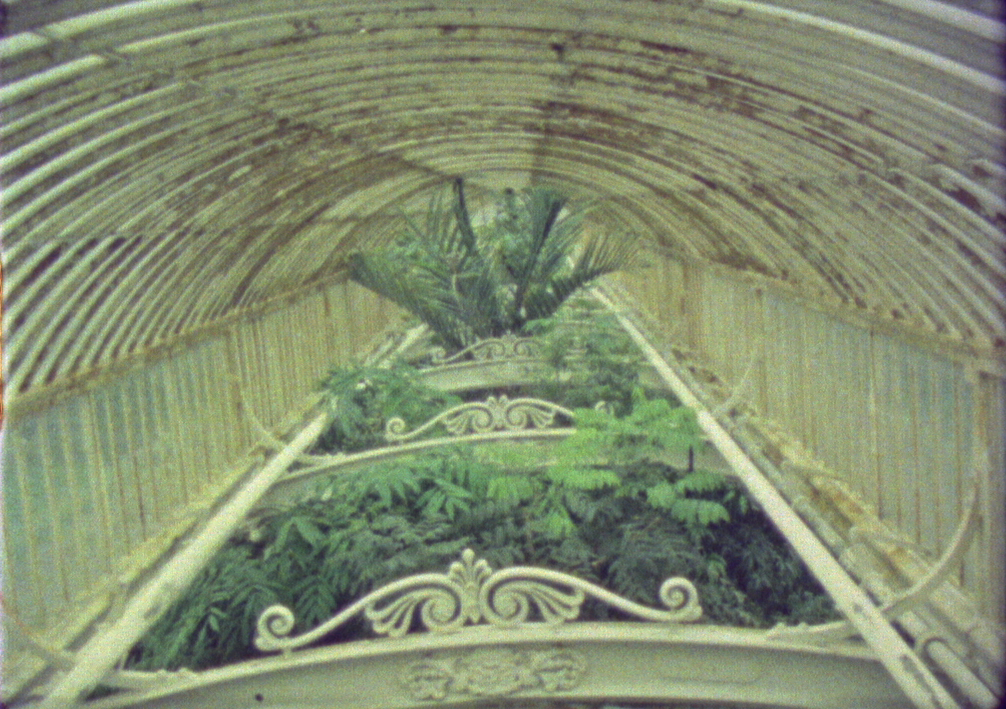Curated by Giulia Simi.
“La natura dell’archivio” is the festival section dedicated to contaminations between the botanical world and memory, film, and archives. This year, the section hosts the installation Kew. A conversation in green by Adelaide Cioni.
La Natura dell’archivio
Starting from Adelaide Cioni, Kew. A Conversation in Green
Doesn’t one always think of the past, in a garden?
– Virginia Woolf, Kew Gardens, 1919
There is always a feeling of “moving on the margins” in Adelaide Cioni’s visual research, a desire to capture the outer traces of reality that vibrate like a presence, that is sometimes buried in our bodies and comes to the surface through the enchantment of reminiscence. It is a real encounter with the memory of the world, with the awareness that we exist only as parts of a great organism that flows within a time of eternal return. Thus, in front of these slow, grainy, almost obsolete images, in this careful, almost tactile observation of palm leaves in their various shapes, where everything is repeated but nothing is ever the same, it feels as though we are rediscovering the lifeblood of our existence in the world. “Doesn’t one always think of the past in a garden?” Virginia Woolf observed in one of her most experimental stories, Kew Gardens, which was published in a 1919 edition illustrated by Vanessa Bell’s engravings and finds here a ghostly and surprising resonance.
Indeed, the past invades the images of these curvilinear leaves, filmed in Super 8 and screened here in 16mm, flowing between the silences of the images and those of the spaces that were once a refectory for Dominican nuns. These are leaves that ask us questions, often resting on the surface of glass and metals worn and weathered by time, sometimes abandoned by life, constantly crossed by the pale light filtering through the transparency of this Palm House, inaugurated at the height of the race for great technological progress and now immersed in the dust of times long gone. Light and movement. Just like cinema.
Palms, so beloved during the colonial fascination for the exotic in the Victorian era, are but a symptom, a manifestation of a past that emerges in the interweaving of historical times. There was also a palm in the temple of Delos, so well-known that it was evoked by Homer through the voice of Odysseus as a term of comparison for the beauty of Nausicaa. Palms are seen in Roman and Byzantine mosaics, in church frescoes, in paintings in museums, and in photographs from the early days of luxury tourism in the South of France, anticipating the glamorous shots of the Cannes Film Festival. In their most remote varieties, parlor palms crowded the living rooms of the 19th and early 20th centuries. Two parlor palms appear in the famous photograph of the Lumière Brothers’ first screening in Paris, in the renowned Salon Indien du Grand Café on Boulevard des Capucines. They fill melodramas as early as the 1910s, caressing the sinuous bodies of divas, and it almost seems like we can see their shadows when we imagine the screenings of the first family films in the living rooms of bourgeois homes by the mid-1920s. But in gazing at these lance-shaped leaves, where light filters and blends with matter, the mind plunges and takes a leap even further, into another time and place that feels like an epiphany, and just like an epiphany, disorients us. A place that is fully present, unraveling boundaries and perhaps eras, reminding us that everything is body, and everything is life. With their relentless and unceasing lines, these leaves invade glass and walls, press against the ceiling, fill stairs and balconies, constantly spilling out of the frame, challenging our eyes and senses as if we were in a labyrinth. They elude us and pursue us at the same time. Clarice Lispector wrote in her masterpiece about the power of existence, The Passion According to G.H.: “And look at the leaves, how green and heavy they are, the leaves that grow exasperated into something, how blind the leaves are, and how green. And feel in your hand how everything has weight. […] Only things with weight can fly.”
Memory, too, has weight, and memory, like nature, can fly. In this conversation in green where even a robin appears to remind us of the inextricable bond between the plant and animal worlds, it happens that we perceive not only the moment of an elsewhere that is both a before and an after, but also to recognize the flash of a previously seen image. We thus discover that, between the patterns of the leaves and the loop of a 16mm projector, our body speaks and draws memory.
This is the nature of the archive, too.
–
Opening hours and entry
Sala Berti – Refettorio delle Monache dell’ex Convento San Mattia, Via Sant’Isaia 20
Kew. A Conversation in Green – Adelaide Cioni
16mm film loop installation, drawings of Indian ink and vinyl paint on paper
Opening hours (free entry)
October 23rd, from 15:00 – 18:00
October 24th to the 27th, from 10:00 – 19:00
